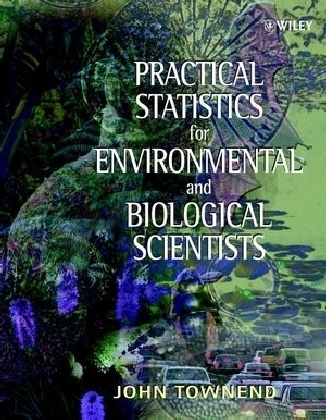
Practical Statistics for Environmental and Biological Scientists
John Wiley & Sons Inc (Verlag)
978-0-471-49665-6 (ISBN)
Practical Statistics for Environmental and Biological Scientists provides a concise, user-friendly, non-technical introduction to statistics. The book covers planning and designing an experiment, how to analyse and present data, and the limitations and assumptions of each statistical method. The text does not refer to a specific computer package but descriptions of how to carry out the tests and interpret the results are based on the approaches used by most of the commonly used packages, e.g. Excel, MINITAB and SPSS. Formulae are kept to a minimum and relevant examples are included throughout the text.
John Townend is the author of Practical Statistics for Environmental and Biological Scientists, published by Wiley.
Preface ix
Part I Statistics Basics 1
1 Introduction 3
1.1 Do you need statistics? 3
1.2 What is statistics? 4
1.3 Some important lessons I have learnt 5
1.4 Statistics is getting easier 6
1.5 Integrity in statistics 7
1.6 About this book 8
2 A Brief Tutorial on Statistics 9
2.1 Introduction 9
2.2 Variability 9
2.3 Samples and populations 10
2.4 Summary statistics 11
2.5 The basis of statistical tests 19
2.6 Limitations of statistical tests 24
3 Before You Start 27
3.1 Introduction 27
3.2 What statistical methods are available? 28
3.3 Surveys and experiments 33
3.4 Designing experiments and surveys — preliminaries 35
3.5 Summary 43
4 Designing an Experiment or Survey 45
4.1 Introduction 45
4.2 Sample size 45
4.3 Sampling 50
4.4 Experimental design 56
4.5 Further reading 60
5 Exploratory Data Analysis and Data Presentation 63
5.1 Introduction 63
5.2 Column graphs 65
5.3 Line graphs 67
5.4 Scatter graphs 69
5.5 General points about graphs 71
5.6 Tables 73
5.7 Standard errors and error bars 74
6 Common Assumptions or Requirements of Data for Statistical Tests 77
6.1 Introduction 77
6.2 Common assumptions 81
6.3 Transforming data 84
Part II Statistical Methods 91
7 t-tests and F-tests 93
7.1 Introduction 93
7.2 Limitations and assumptions 94
7.3 t-tests 95
7.4 F-test 103
7.5 Further reading 105
8 Analysis of Variance 107
8.1 Introduction 107
8.2 Limitations and assumptions 109
8.3 One-way ANOVA 111
8.4 Multiway ANOVA 119
8.5 Further reading 127
9 Correlation and Regression 129
9.1 Introduction 129
9.2 Limitations and assumptions 130
9.3 Pearson’s product moment correlation 131
9.4 Simple linear regression 135
9.5 Correlation or regression? 142
9.6 Multiple linear regression 143
9.7 Comparing two lines 146
9.8 Fitting curves 148
9.9 Further reading 151
10 Multivariate ANOVA 153
10.1 Introduction 153
10.2 Limitations and assumptions 154
10.3 Null hypothesis 156
10.4 Description of the test 156
10.5 Interpreting the results 158
10.6 Further reading 161
11 Repeated Measures 163
11.1 Introduction 163
11.2 Methods for analysing repeated measures data 166
11.3 Designing repeated measures experiments 170
11.4 Further reading 170
12 Chi-square Tests 173
12.1 Introduction 173
12.2 Limitations and assumptions 174
12.3 Goodness of fit test 175
12.4 Test for association between two factors 178
12.5 Comparing proportions 181
12.6 Further reading 184
13 Non-parametric Tests 185
13.1 Introduction 185
13.2 Limitations and assumptions 188
13.3 Mann—Whitney U-test 189
13.4 Two-sample Kolmogorov—Smirnov test 191
13.5 Two-sample sign test 193
13.6 Kruskal—Wallis test 195
13.7 Friedman’s test 198
13.8 Spearman’s rank correlation 200
13.9 Further reading 203
14 Principal Component Analysis 205
14.1 Introduction 205
14.2 Limitations and assumptions 207
14.3 Description of the method 207
14.4 Interpreting the results 209
14.5 Further reading 218
15 Cluster Analysis 221
15.1 Introduction 221
15.2 Limitations and assumptions 222
15.3 Clustering observations 223
15.4 Clustering variables 226
15.5 Further reading 228
Appendices 229
A Calculations for statistical tests 231
B Concentration data for Chapters 14 and 15 247
C Using computer packages 249
D Choosing a test: decision table 261
E List of worked examples 265
Bibliography 271
Index 273
| Erscheint lt. Verlag | 29.1.2002 |
|---|---|
| Verlagsort | New York |
| Sprache | englisch |
| Maße | 246 x 244 mm |
| Gewicht | 476 g |
| Themenwelt | Mathematik / Informatik ► Mathematik ► Statistik |
| Naturwissenschaften ► Biologie ► Allgemeines / Lexika | |
| Naturwissenschaften ► Biologie ► Ökologie / Naturschutz | |
| ISBN-10 | 0-471-49665-0 / 0471496650 |
| ISBN-13 | 978-0-471-49665-6 / 9780471496656 |
| Zustand | Neuware |
| Haben Sie eine Frage zum Produkt? |
aus dem Bereich


